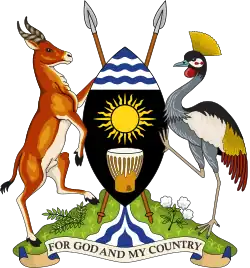.jpg.webp)
| Islam by country |
|---|
 |
|
|
Uganda is an overwhelmingly Christian majority country, with Islam being the second most widely professed faith. According to the 2014 National Census, Islam in Uganda was practised by 14 percent of the population.[1] The Pew Research Center in 2014, however, estimated that 11.5 percent of Ugandans were Muslim, compared to 35.2 percent of Tanzanians, 9.7 percent of Kenyans, 6.2 percent of South Sudanese, 2.8 percent of Burundians, and 1.8 percent of Rwandans.[2] The vast majority of Muslims in Uganda are Sunni. Small Shia and Ahmadi minorities are also present.[3]
The Iganga District in the east of Uganda had the highest percentage of Muslims according to a 2009 published report.[4]
History
The presence of Islam in Uganda was first recorded in 1844 when an Arab trader preached to Suuna II, the ruler of the Kingdom of Buganda in central Uganda. Later adopted by Muteesa I as the state religion of his kingdom and then retracted by his son and successor Mwanga II, Baganda Muslims spread across the lands that would become Uganda. Islam was also spread throughout Uganda by Muslim colonial administrators who originally worked in northern Uganda when it was by controlled by the Khedivate of Egypt but were later employed by British colonial administrator Frederick Lugard when Egyptian control collapsed in the south.[5] Despite persecution by the British, Islam flourished in the colonial period and was said to be fastest growing religion in Uganda by a colonial officer in the 1950s. Mosques were built in almost every established city in Uganda and the Uganda Muslim Education Association, founded by prince Badru Kakungulu with help by Asian Muslims, built hundreds of primary schools through introducing western educational curriculum into madrasah schools across the country.[6]
2002 census
.jpg.webp)
The 2002 national census recorded that Muslims represented 12.1 percent of the population.[7]: 11
| Region | % Muslim |
|---|---|
| Central | 18.4%[8] |
| Eastern | 17.0%[8] |
| Northern | 8.5%[8] |
| Western | 4.5%[8] |
| Total | 12.1% |
Geographical distribution
Yumbe District is the only district with a Muslim-majority (76%). Muslims form a significant minority in the districts of Mayuge (36%) and Iganga (34%).
| Region/District | Population (2014 census) [9] |
Number of Muslims | Share of Muslims |
|---|---|---|---|
| Kampala District | 1,187,795 | 268,787 | 22.6% |
| Iganga District | 708,630 | 239,582 | 33.8% |
| Yumbe District | 251,758 | 191,913 | 76.2% |
| Mukono District | 795,114 | 165,817 | 20.9% |
| Masaka District | 770,379 | 164,950 | 21.4% |
| Wakiso District | 907,736 | 164,256 | 18.1% |
| Mbale District | 717,534 | 132,247 | 18.4% |
| Arua District | 833,538 | 123,229 | 14.8% |
| Mayuge District | 324,668 | 117,526 | 36.2% |
| Kamuli District | 707,242 | 112,177 | 15.9% |
| Bugiri District | 412,365 | 101,571 | 24.6% |
| Jinja District | 387,249 | 100,257 | 25.9% |
| Pallisa District | 520,532 | 94,231 | 18.1% |
| Luwero District | 478,492 | 89,232 | 18.6% |
| Mpigi District | 407,739 | 87,314 | 21.4% |
| Kayunga District | 294,568 | 76,127 | 25.8% |
| Mubende District | 689,305 | 74,781 | 10.8% |
| Tororo District | 536,732 | 63,381 | 11.8% |
| Mbarara District | 1,088,012 | 61,273 | 5.6% |
| Rakai District | 470,144 | 51,348 | 10.9% |
| Moyo District | 194,734 | 35,569 | 18.3% |
| Kasese District | 522,726 | 33,790 | 6.5% |
| Masindi District | 459,244 | 31,753 | 6.9% |
| Bushenyi District | 731,217 | 31,293 | 4.3% |
| Sironko District | 283,056 | 28,961 | 10.2% |
| Kiboga District | 229,297 | 27,839 | 12.1% |
| Sembabule District | 180,028 | 27,408 | 15.2% |
| Busia District | 224,887 | 22,322 | 9.9% |
| Ntungamo District | 379,829 | 20,688 | 5.1% |
| Bundibugyo District | 209,820 | 18,601 | 8.9% |
| Nebbi District | 435,252 | 17,829 | 4.1% |
| Kabarole District | 356,704 | 17,696 | 5.0% |
| Hoima District | 343,480 | 17,438 | 5.1% |
| Kapchorwa District | 190,282 | 16,324 | 8.6% |
| Kibaale District | 405,761 | 13,044 | 3.2% |
| Kyenjojo District | 377,109 | 11,754 | 3.1% |
| Kumi District | 389,599 | 11,632 | 3.0% |
| Adjumani District | 202,223 | 11,273 | 5.6% |
| Kamwenge District | 263,595 | 10,865 | 4.1% |
| Lira District | 740,893 | 9,566 | 1.3% |
| Nakasongola District | 127,048 | 9,428 | 7.4% |
| Soroti District | 369,621 | 8,541 | 2.3% |
| Kanungu District | 204,640 | 5,564 | 2.7% |
| Rukungiri District | 275,101 | 5,339 | 1.9% |
| Kalangala District | 34,699 | 4,986 | 14.4% |
| Gulu District | 475,071 | 4,597 | 1.0% |
| Apac District | 683,987 | 3,999 | 0.6% |
| Kabale District | 458,107 | 3,753 | 0.8% |
| Katakwi District | 298,900 | 3,131 | 1.0% |
| Kotido District | 591,870 | 2,313 | 0.4% |
| Moroto District | 189,907 | 1,707 | 0.9% |
| Kisoro District | 220,202 | 1,693 | 0.8% |
| Kitgum District | 282,270 | 1,617 | 0.6% |
| Pader District | 326,320 | 1,463 | 0.4% |
| Nakapiripirit District | 154,494 | 1,390 | 0.9% |
| Kaberamaido District | 131,627 | 956 | 0.7% |
| Uganda (total) | 24,433,132 | 2,956,121 | 12.1% |
See also
References
- ↑ "Uganda". United States Department of State. Retrieved 2023-12-07.
- ↑ "Global Religious Diversity: Appendix 2, Religious Diversity Index Scores and Religious Adherents by Region and Country" (PDF). Pew Research Center. 4 April 2014. Retrieved 19 January 2017.
- ↑ "The World's Muslims: Unity and Diversity" (PDF). Pew Forum on Religious & Public life. 9 August 2012. Archived from the original (PDF) on 24 October 2012. Retrieved 14 August 2012.
- ↑ United States Department of State (26 October 2009). "Uganda". International Religious Freedom Report 2009. Archived from the original on 30 November 2009. Retrieved 2010-06-05.
- ↑ Kasozi 1985, p. 36.
- ↑ Kasozi 1985, p. 36-37.
- ↑ "2002 Uganda Population and Housing Census - Main Report" (PDF). Uganda Bureau of Statistics. Archived from the original (PDF) on 12 October 2017. Retrieved 19 January 2017.
- 1 2 3 4 "2002 Uganda Population and Housing Census - Population Composition (Household Composition, Religious and Ethnic Composition and Marriage)" (PDF). Uganda Bureau of Statistics. Retrieved 8 September 2018.
- ↑ http://www.ubos.org/onlinefiles/uploads/ubos/centableB7.pdf
 This article incorporates text from this source, which is in the public domain. Country Studies. Federal Research Division.
This article incorporates text from this source, which is in the public domain. Country Studies. Federal Research Division.
Bibliography
- Kasozi, Abdu B.K. (January 1985). "The Uganda Muslim supreme council: an experiment in Muslim administrative centralisation and institutionalisation, 1972–82". Institute of Muslim Minority Affairs Journal. 6 (1): 34–52. doi:10.1080/13602008508715923.
Further reading
- Kasule, Joseph (2022). Islam in Uganda: The Muslim Minority, Nationalism & Political Power. Boydell & Brewer. ISBN 9781847012432.
